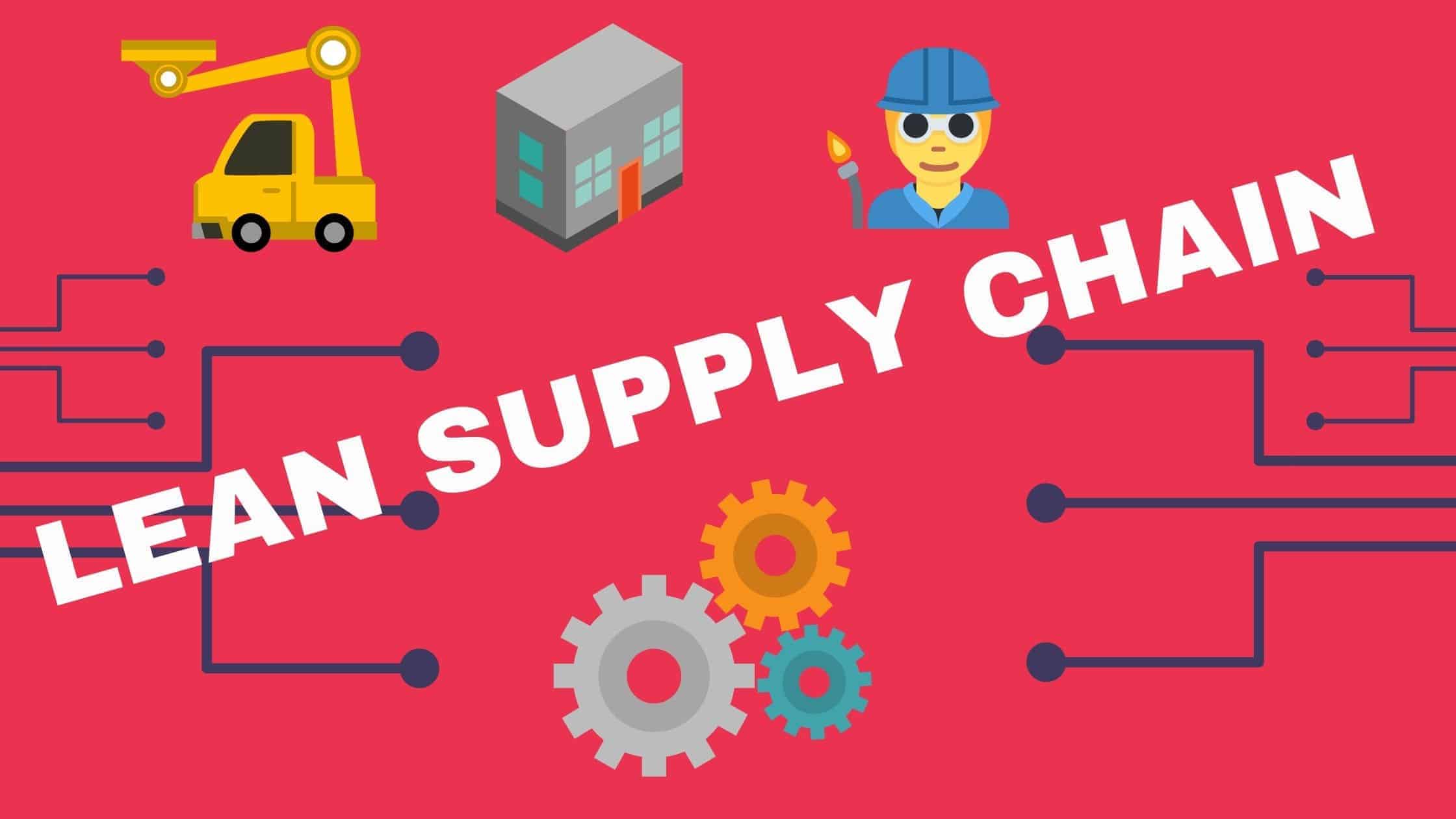
.
Lean Supply Chain is a network enterprise model that looks at the enterprise from the overall perspective of the market and the whole thinking of the system. Supply chains exist in manufacturing enterprises, services and other sectors. With the application of lean management thinking, the concept of lean supply chain has emerged.
.
What Is a Lean Supply Chain?
.
Lean Supply Chain is derived from lean management. It integrates the necessary steps and partners from the product design to the customer to get the product. It responds quickly to the changing needs of customers. The core is to reduce and eliminate waste in the enterprise and meet customer needs to the greatest extent with as few resources as possible. The emergence of lean supply chain has become an effective method to reduce waste, reduce costs, shorten operating cycles, and provide enhanced customer value to enhance the competitive advantage of enterprises.
.
Brief summary of the essential concepts
Lean production refers to a method of minimizing waste and reducing costs and production time, inspired by the Japanese car manufacturer Toyota, and popularized with the term “lean”, slender, in the 1990s. In particular, it involves reducing 3 types of waste i.e.
.
1) processes or activities that do not add value (e.g. overproduction or unnecessary displacement of items)
2) unevenness (e.g. irregular hours, periods of inactivity followed by acceleration)
3) overloaded (e.g. overburdened workers with excessive weights or equipped with inadequate gear, or teams or machines pushed beyond reasonable limits).
.
An extension of lean production also involves creating smoother flows in production and reducing bottlenecks.
.
Rather than tools, lean manufacturing takes a cultural and managerial approach that is characterized by a standardized and simplified strategy and procedures, designed and implemented by a leadership whose goal is continuous improvement, with respect for people in mind.
.
What is a lean supply chain?
.
Lean supply chain is a term used to describe a supply chain management process that ensures that the company has all the resources at hand to produce at full capacity without unnecessarily increasing supply and raw inventory material. This arrangement has many advantages, including lower tax assessments and reduced storage costs. Considered one of the most effective forms of supply chain management, a lean supply chain approach frees up a large portion of the company’s cash resources while still making full use of all raw materials.
.
The foundation of a lean supply chain is to keep enough raw materials on hand, but not too high. The idea is to have enough resources to keep the operation going until the next batch of material arrives from the supplier. This requires close monitoring of the use of the material at hand and determining the time it takes the supplier to fill and deliver the order. If managed effectively, ordering schedules can be established to ensure that production is not disrupted and that raw materials are not wasted in the warehouse for long periods of time. Ideally, when the vendor’s next delivery arrives, the material on hand will run out, so it is necessary to store the newly arrived items no more than a few days before the production site.
.
While one aspect of the lean supply chain is related to maintaining low inventories, the process often involves carefully studying how raw materials and supplies are used in the production process. Here, the focus is on ensuring that waste is kept to an absolute minimum. Sometimes this may involve changing the layout of the production floor or replacing equipment or machinery that no longer makes the most efficient use of materials used in the production process. By keeping the waste as low as possible, this, in turn, helps to construct the reordering of raw materials, so that fewer resources are required to produce the same quantity of products, and inventory can be reduced.
The main benefit of establishing a lean supply chain process is that smaller inventory means a smaller tax assessment. In many countries around the world, companies tax their supply and stock of raw materials even if they are taxed on any manufactured goods that are currently in storage and waiting for customers to purchase. By keeping these supplies and raw inventory low, businesses can help minimize the tax burden and spend more of their revenue on other functions, including financing strategies that help grow their businesses.
.
Lean supply chain management consists of six areas:
.
First – Understanding the extended manufacturing process at the same time, eliminate the bottleneck of internal manufacturing, to ensure that the overall process has a faster-operating cycle
Second – Focus on the optimal efficiency of assets, and apply the theory of limitation, to eliminate the often unnecessary inventory and potential production waste in factory operations
Third – To create a “control center platform” to manage and drive the concentration and visibility of inventory and procurement information, to eliminate excessive inventory generation and control inventory fluctuations unnecessary steps
Fourth – Strengthen Supplier relationship management to ensure that key suppliers can also focus on eliminating bottlenecks and unnecessary steps in their internal operations
Fifth – Improve the speed and efficiency of the planning process to avoid data delays and implement outdated programmes
Sixth – Use technology to manage demand uncertainty and balance demand with supply to avoid overstocking and related significant waste
.
Choosing a lean supply chain strategy has significant measurable benefits for upstream and downstream supplier management, including reducing the uncertainty in the supply chain due to inaccurate consumer demand forecasts, reducing lead times and ensuring a rapid response to market changes. When lean strategies are successfully applied, businesses can increase revenue and cost advantage by improving performance.
.
How to achieve lean supply chain management?
.
Enterprises need to continuously optimize the supply chain management system, so as to reduce procurement, operation and other costs, and ultimately improve the service level of the enterprise supply chain platform and respond to the changing market flexibility.
.
The core issue of lean management is to eliminate all unnecessary activities in the supply chain, simplify processes across the supply chain, increase flexibility, and bring more value to customers.
.
In implementing lean supply chain, supply chain managers use a variety of different approaches, such as 6-inch, SCOR models, Kanban management, and VMI. Either way, however, the ultimate goal of a lean supply chain strategy is to enable an efficient and responsive organization that synchronizes supply chain processes and responds to changes in customer needs. To achieve this, participants in all supply chains must have visibility to information and thus greater control over intercompany processes.
.
But the reality is that competition in the market forces companies to increase the variety of products and outsource more and more business. Each company relies on external organizations to do many things in the supply chain process.
.
As a result, no company has full visibility into the end-to-end overall supply chain process.
.
Without visibility and timely and accurate information, supply chain managers cannot effectively control processes and eliminate waste. For example, if changes in demand cannot be delivered to the supplier in a timely manner, there will be excess or shortage of inventory, and suppliers may experience miscommunication or delayed order confirmation if supply constraints do not become apparent in the supply chain in a timely manner. Similarly, if the system is not integrated or if the data is not in a shared mode, it will not only waste time and money, but also lead to errors due to manual integration.
.
The key to lean supply chain is to achieve synchronization and information visibility of all parties in the supply chain.
.
A single real-time information is essential for all supply chain participants and is key to achieving concerted action across the supply chain. Even a very simple process, such as a single order, can be improved by achieving visibility of information in the supply chain.
.
For example, retailers buy computers for their stores and place orders for computer manufacturers. The computer manufacturer’s central purchasing office accepts orders and arranges production and manufacturing, which is then delivered through their third-party logistics partners. The order is forwarded to the retailer’s 3PL partner before it is assigned to the retailer’s store.
.
In this simple process, there are 4 parties involved:
.
3PL partners for retailers, retailers, computer manufacturers, and computer manufacturers. Real-time visibility of information in the order confirmation process, advance shipment notification, and receipt notification process esquire will help eliminate additional work such as manual tracking of order status and enable all parties in the supply chain management system to work efficiently.
.
Lean supply chain management focuses on achieving zero-defect goals by quickly identifying and solving problems. Real-time exception incident notifications significantly reduce the time it takes to identify and resolve issues and reduce squabbles between parties in the supply chain.
.
Automatic management of exception processes allows supply chain managers to focus on activities that add more value, such as long-term improvement solutions. Process automation is the second pillar of eliminating supply chain waste, using the concept of simple automation plus manual intervention management.
.
Information Technology advancement
.
The continuous advancement of information technology not only provides the ability of supply chain processes to alert to exceptional events, but also provides timely alternatives. For example, a supply chain system can suggest the quantity of demand based on demand parameters, current inventory in the warehouse and production cycle. One possible proposal is to take no action when demand significantly exceeds the original estimate. Because the inventory of the VMI centre or future shipments from the vendor show that this new requirement can be met. Another possible proposal would be to launch alternative suppliers to meet the growth in demand while avoiding the crisis of production shutdowns.
.
Real-time notification of issues in the supplier management system ensures consistency of intercompany processes and a timely response to changes in customer needs. With this type of exception event management system, participants in the supply chain can respond quickly and effectively to fluctuations in demand or supply to avoid more serious crises.
.
However, since each supply chain is unique, with its own set of constraints, processes, specificity – and inheritance – the process of conversion to lean SCM usually involves dedicated investments, as there are no ready-to-use tools on the market. Such tools should be able to adapt to the specific set of constraints of a supply chain in order to evaluate its performance from the broadest possible perspective, and should be able to accommodate input from different IT systems if necessary. Ideally, a lean initiative can also involve creating a system to collect all the data, that is, a data lake. This would be the basis of any further initiative to optimize the supply chain. In addition, IT can also be more leanly restructured.
.
The emergence of lean supply chain has become another important methodology to reduce waste, reduce costs, shorten the cycle, increase customer value and enhance the competitiveness of enterprises.
.
What is Supply Chain Management?
.
.
